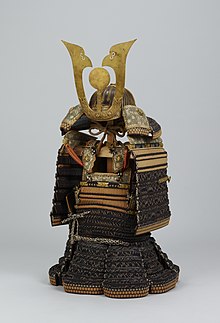| This article needs additional citations for verification. Please help improve this article by adding citations to reliable sources. Unsourced material may be challenged and removed. Find sources: "Dō-maru" – news · newspapers · books · scholar · JSTOR (November 2010) (Learn how and when to remove this message) |


| External image | |
|---|---|
Dō-maru (胴丸), or "body wrap", is a type of chest armour (dou or dō) that was worn by the samurai class of feudal Japan. Dō-maru first appeared in the 11th century, as an armour for lesser samurai and retainers. Like the ō-yoroi style it became more common in the Genpei War at the end of the 12th century.
Description
There were quite a number of similar styles and types of Japanese armor; the dō-maru is particularly defined by the fact that a dō-maru opens on the right side as opposed to the haramaki style, which opens in the back, and the ō-yoroi, the cuirass of which is completely open on the right side, requiring a separate plate (waidate) to cover the right side. The ō-yoroi is a heavy, box-like type of armour meant for use on horseback, and was expensive to make. The dō-maru, like the haramaki, has more skirt plates (kusazuri) than an ō-yoroi and is lighter, closer-fitting, and cheaper to create. The dō-maru was easier to fight with on foot and eventually even higher status samurai adopted it over the ō-yoroi.
Dō-maru were constructed from small scales of leather or metal laced into plates with cord and lacquered, then each plate was laced together to form the armor. Due to the weight of iron, armour makers limited its use to the most vital parts of the armor and used leather for the remainder.
See also
References
- "Warrior in domaru armor". The Costume Museum - The Rebirth of The Tale of Genji. Archived from the original on Nov 26, 2023.
- Oriental Armour, H. Russell Robinson, Courier Dover Publications, 2002 P.180
- Sinclaire, Clive (2004). Samurai: The Weapons and Spirit of the Japanese Warrior, Clive Sinclaire, Globe Pequot, 2004 P.29. Globe Pequot Press. ISBN 9781592287208. Archived from the original on 2014-02-19. Retrieved 2016-10-17.
External links
- "Warrior in domaru armor". The Costume Museum - The Rebirth of The Tale of Genji.
- Anthony Bryant's web site Archived 2019-07-27 at the Wayback Machine
| Japanese weapons, armour and equipment | |||||
|---|---|---|---|---|---|
| Swords |
| ||||
| Knives and daggers | |||||
| Polearms and spears | |||||
| Practice weapons | |||||
| Armour |
| ||||
| Clothing | |||||
| Samurai accoutrements | |||||
| Chain and rope weapons | |||||
| Clubs and truncheons | |||||
| Staff weapons | |||||
| Projectile and throwing weapons | |||||
| Firearms and guns | |||||
| Improvised and other weapons | |||||
| Signal devices | |||||
| Users | |||||